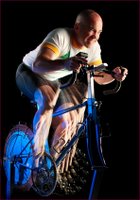 Dr. Ivan Schwab as a Dryocopus pileatus
Dr. Ivan Schwab as a Dryocopus pileatusEver wonder why woodpeckers don't get headaches?
The pileated woodpecker, aka
Dryocopus pileatus, strikes its feathered noggin against trees at a rate up to 20 times per second as many as 12,000 times per day. Dr. Schwab, who's studied such stuff, estimates this rap star generates forces equivalent to banging human heads face first against a wall at 16 mph!
So how does the noble woodpecker avoid brain damage and subdural hematomas with all this head-banging behavior? Dr. Schwab wrote a scholarly article on that very subject for the
British Journal of Ophthalmology, citing among other protective mechanisms the woodpecker's spongy skull which cushions the blows. And its brain, which is tightly packed into the space, has little room to slosh around against the bony walls.
Contrast that with the shrinking brains of aging humans. These little old control centers float unsteadily in thinned-out skulls, swaying dangerously as frail feet stumble. If head meets bathroom wall after toe catches in bathroom rug, untethered blood vessels around the brain easily break and spill blood into the space between gray matter and bone.
Dr. Schwab concludes "So, when you complain about your headache, think of the industrious woodpecker." He received an IgNobel prize in biology for his work and attended the awards ceremony dressed as his feathered subject.
 Baked Brie with Nut Crust*
Baked Brie with Nut Crust* Dr. Ivan Schwab as a Dryocopus pileatus
Dr. Ivan Schwab as a Dryocopus pileatus Anti-Hiccup Kit
Anti-Hiccup Kit Got six minutes?
Got six minutes?











 Vertical Strip Breast Exam
Vertical Strip Breast Exam





